Sentence Writing Strategy: A Case Study of a High School Student
VerifiedAdded on 2023/06/13
|43
|4074
|336
Practical Assignment
AI Summary
This assignment presents a sentence writing strategy implemented with a high school student in Colorado who faced challenges in constructing simple sentences and understanding more complex sentence structures. The strategy employs controlled practice to reinforce basic sentence components such as subjects and verbs, and gradually introduces compound and complex sentence formations. The student's understanding is assessed through quizzes and work samples, reflecting improvements in identifying and constructing various sentence types. The narrative includes reflections on the instructional sequence, highlighting the importance of tailored teaching approaches to address learning disabilities and enhance grammar skills. The assignment underscores the effectiveness of targeted interventions in improving sentence proficiency among students with learning difficulties, and emphasizes the role of patience, repetition, and varied learning materials in facilitating comprehension and confidence in sentence writing.
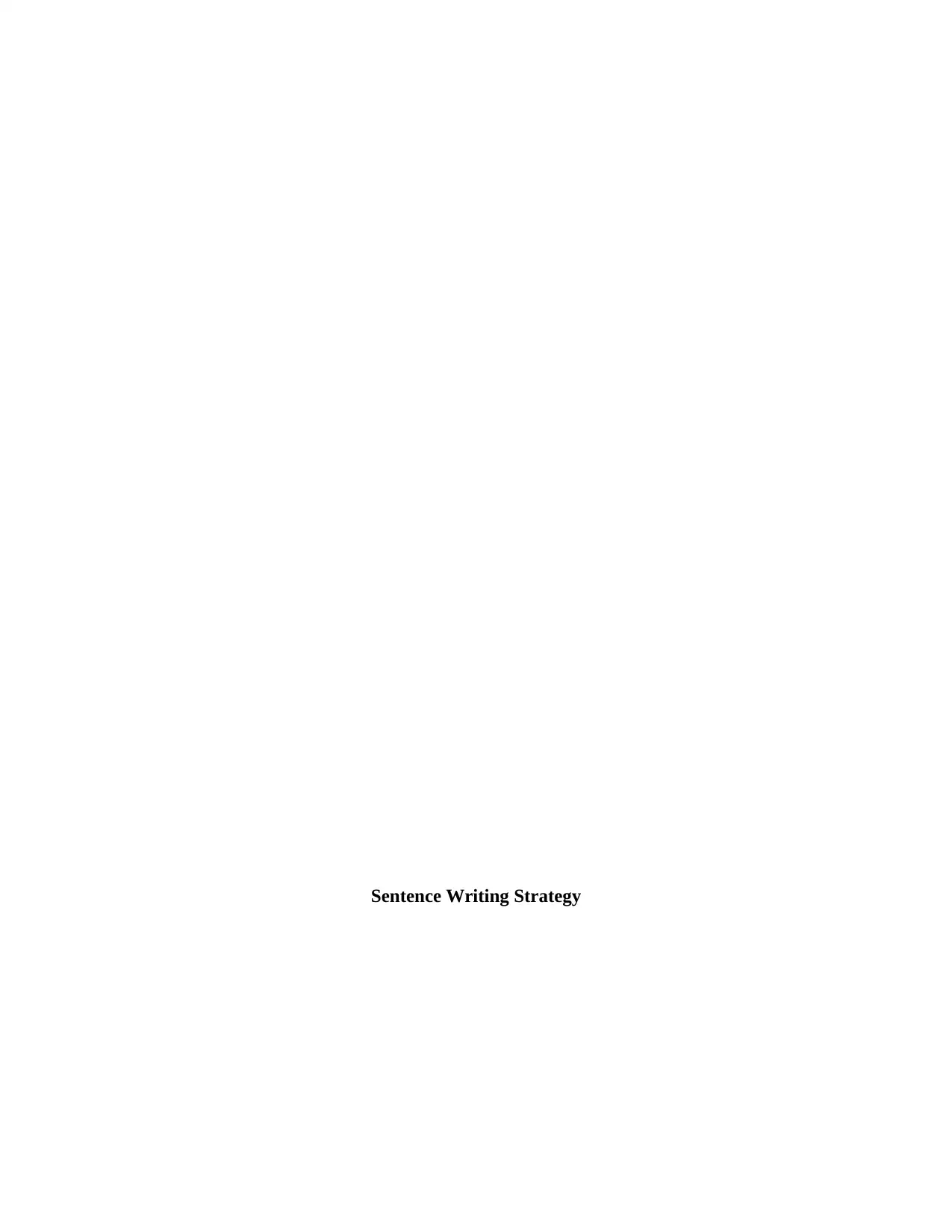
Sentence Writing Strategy
Paraphrase This Document
Need a fresh take? Get an instant paraphrase of this document with our AI Paraphraser
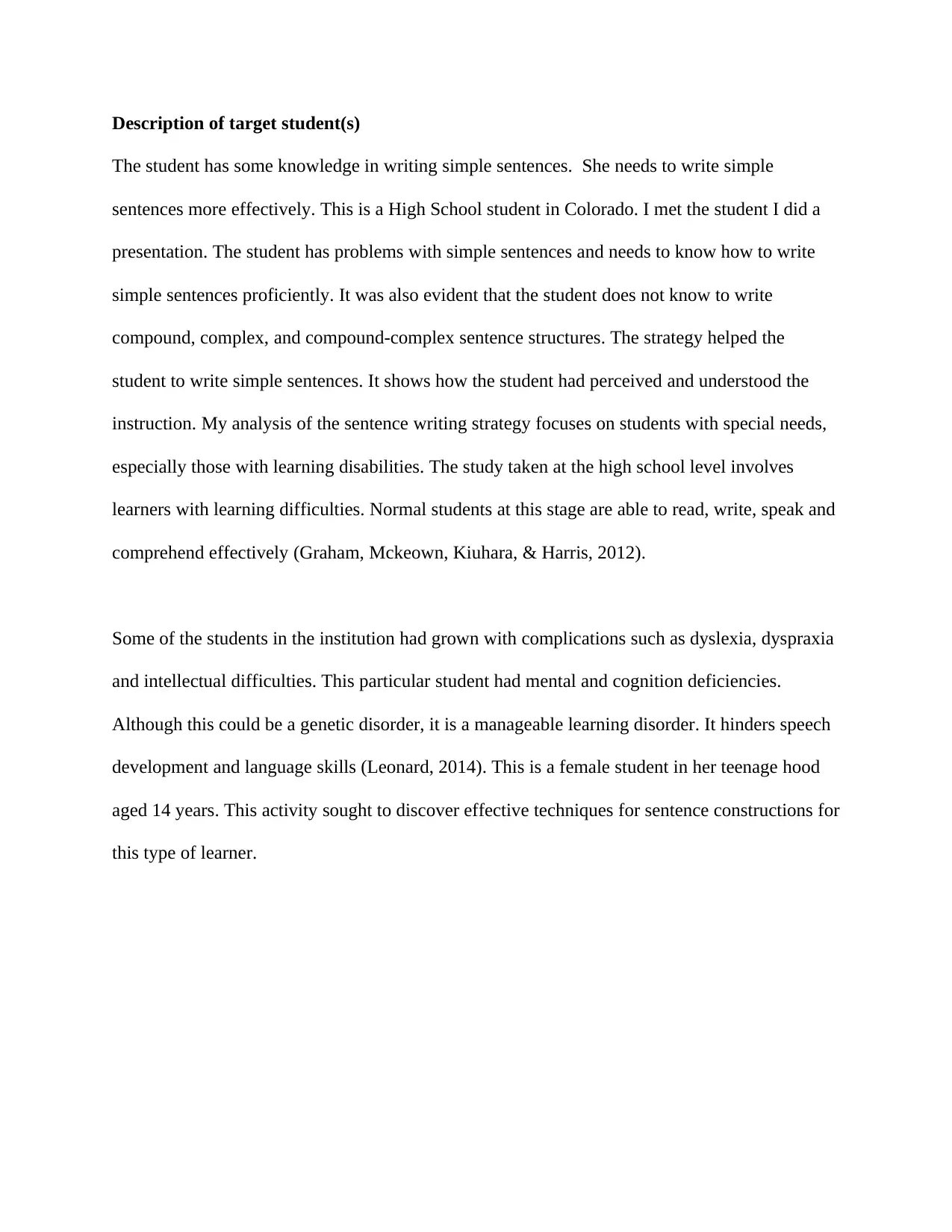
Description of target student(s)
The student has some knowledge in writing simple sentences. She needs to write simple
sentences more effectively. This is a High School student in Colorado. I met the student I did a
presentation. The student has problems with simple sentences and needs to know how to write
simple sentences proficiently. It was also evident that the student does not know to write
compound, complex, and compound-complex sentence structures. The strategy helped the
student to write simple sentences. It shows how the student had perceived and understood the
instruction. My analysis of the sentence writing strategy focuses on students with special needs,
especially those with learning disabilities. The study taken at the high school level involves
learners with learning difficulties. Normal students at this stage are able to read, write, speak and
comprehend effectively (Graham, Mckeown, Kiuhara, & Harris, 2012).
Some of the students in the institution had grown with complications such as dyslexia, dyspraxia
and intellectual difficulties. This particular student had mental and cognition deficiencies.
Although this could be a genetic disorder, it is a manageable learning disorder. It hinders speech
development and language skills (Leonard, 2014). This is a female student in her teenage hood
aged 14 years. This activity sought to discover effective techniques for sentence constructions for
this type of learner.
The student has some knowledge in writing simple sentences. She needs to write simple
sentences more effectively. This is a High School student in Colorado. I met the student I did a
presentation. The student has problems with simple sentences and needs to know how to write
simple sentences proficiently. It was also evident that the student does not know to write
compound, complex, and compound-complex sentence structures. The strategy helped the
student to write simple sentences. It shows how the student had perceived and understood the
instruction. My analysis of the sentence writing strategy focuses on students with special needs,
especially those with learning disabilities. The study taken at the high school level involves
learners with learning difficulties. Normal students at this stage are able to read, write, speak and
comprehend effectively (Graham, Mckeown, Kiuhara, & Harris, 2012).
Some of the students in the institution had grown with complications such as dyslexia, dyspraxia
and intellectual difficulties. This particular student had mental and cognition deficiencies.
Although this could be a genetic disorder, it is a manageable learning disorder. It hinders speech
development and language skills (Leonard, 2014). This is a female student in her teenage hood
aged 14 years. This activity sought to discover effective techniques for sentence constructions for
this type of learner.
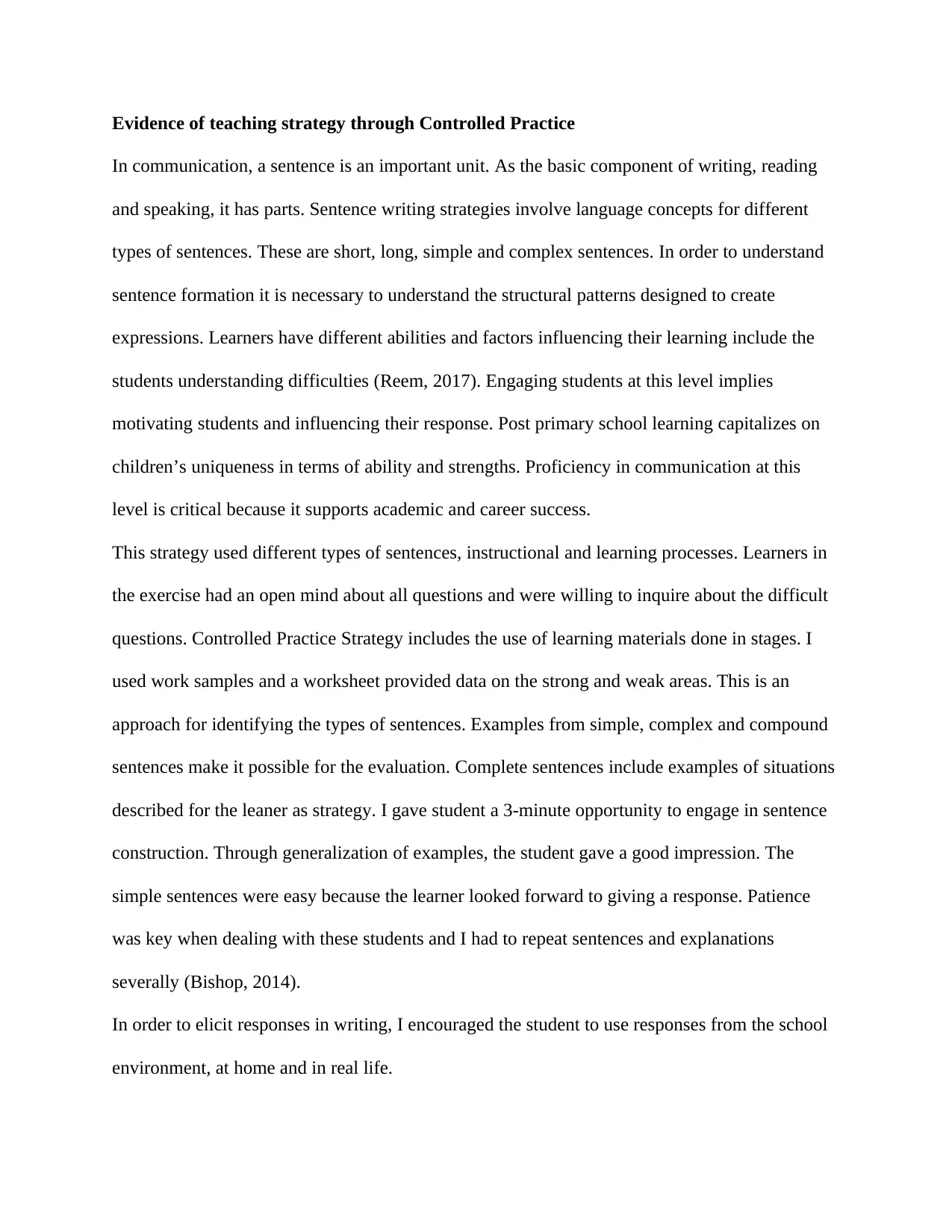
Evidence of teaching strategy through Controlled Practice
In communication, a sentence is an important unit. As the basic component of writing, reading
and speaking, it has parts. Sentence writing strategies involve language concepts for different
types of sentences. These are short, long, simple and complex sentences. In order to understand
sentence formation it is necessary to understand the structural patterns designed to create
expressions. Learners have different abilities and factors influencing their learning include the
students understanding difficulties (Reem, 2017). Engaging students at this level implies
motivating students and influencing their response. Post primary school learning capitalizes on
children’s uniqueness in terms of ability and strengths. Proficiency in communication at this
level is critical because it supports academic and career success.
This strategy used different types of sentences, instructional and learning processes. Learners in
the exercise had an open mind about all questions and were willing to inquire about the difficult
questions. Controlled Practice Strategy includes the use of learning materials done in stages. I
used work samples and a worksheet provided data on the strong and weak areas. This is an
approach for identifying the types of sentences. Examples from simple, complex and compound
sentences make it possible for the evaluation. Complete sentences include examples of situations
described for the leaner as strategy. I gave student a 3-minute opportunity to engage in sentence
construction. Through generalization of examples, the student gave a good impression. The
simple sentences were easy because the learner looked forward to giving a response. Patience
was key when dealing with these students and I had to repeat sentences and explanations
severally (Bishop, 2014).
In order to elicit responses in writing, I encouraged the student to use responses from the school
environment, at home and in real life.
In communication, a sentence is an important unit. As the basic component of writing, reading
and speaking, it has parts. Sentence writing strategies involve language concepts for different
types of sentences. These are short, long, simple and complex sentences. In order to understand
sentence formation it is necessary to understand the structural patterns designed to create
expressions. Learners have different abilities and factors influencing their learning include the
students understanding difficulties (Reem, 2017). Engaging students at this level implies
motivating students and influencing their response. Post primary school learning capitalizes on
children’s uniqueness in terms of ability and strengths. Proficiency in communication at this
level is critical because it supports academic and career success.
This strategy used different types of sentences, instructional and learning processes. Learners in
the exercise had an open mind about all questions and were willing to inquire about the difficult
questions. Controlled Practice Strategy includes the use of learning materials done in stages. I
used work samples and a worksheet provided data on the strong and weak areas. This is an
approach for identifying the types of sentences. Examples from simple, complex and compound
sentences make it possible for the evaluation. Complete sentences include examples of situations
described for the leaner as strategy. I gave student a 3-minute opportunity to engage in sentence
construction. Through generalization of examples, the student gave a good impression. The
simple sentences were easy because the learner looked forward to giving a response. Patience
was key when dealing with these students and I had to repeat sentences and explanations
severally (Bishop, 2014).
In order to elicit responses in writing, I encouraged the student to use responses from the school
environment, at home and in real life.
⊘ This is a preview!⊘
Do you want full access?
Subscribe today to unlock all pages.

Trusted by 1+ million students worldwide
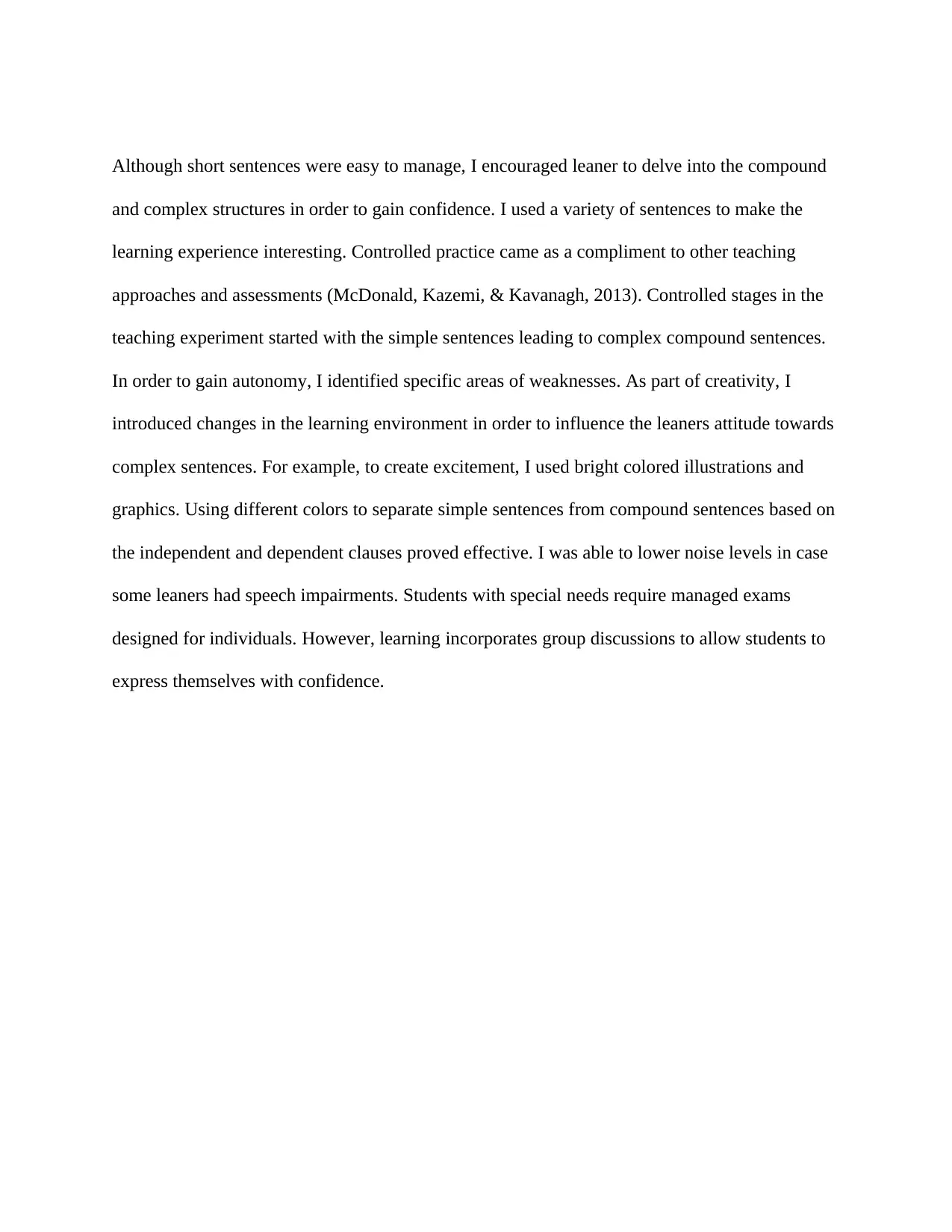
Although short sentences were easy to manage, I encouraged leaner to delve into the compound
and complex structures in order to gain confidence. I used a variety of sentences to make the
learning experience interesting. Controlled practice came as a compliment to other teaching
approaches and assessments (McDonald, Kazemi, & Kavanagh, 2013). Controlled stages in the
teaching experiment started with the simple sentences leading to complex compound sentences.
In order to gain autonomy, I identified specific areas of weaknesses. As part of creativity, I
introduced changes in the learning environment in order to influence the leaners attitude towards
complex sentences. For example, to create excitement, I used bright colored illustrations and
graphics. Using different colors to separate simple sentences from compound sentences based on
the independent and dependent clauses proved effective. I was able to lower noise levels in case
some leaners had speech impairments. Students with special needs require managed exams
designed for individuals. However, learning incorporates group discussions to allow students to
express themselves with confidence.
and complex structures in order to gain confidence. I used a variety of sentences to make the
learning experience interesting. Controlled practice came as a compliment to other teaching
approaches and assessments (McDonald, Kazemi, & Kavanagh, 2013). Controlled stages in the
teaching experiment started with the simple sentences leading to complex compound sentences.
In order to gain autonomy, I identified specific areas of weaknesses. As part of creativity, I
introduced changes in the learning environment in order to influence the leaners attitude towards
complex sentences. For example, to create excitement, I used bright colored illustrations and
graphics. Using different colors to separate simple sentences from compound sentences based on
the independent and dependent clauses proved effective. I was able to lower noise levels in case
some leaners had speech impairments. Students with special needs require managed exams
designed for individuals. However, learning incorporates group discussions to allow students to
express themselves with confidence.
Paraphrase This Document
Need a fresh take? Get an instant paraphrase of this document with our AI Paraphraser
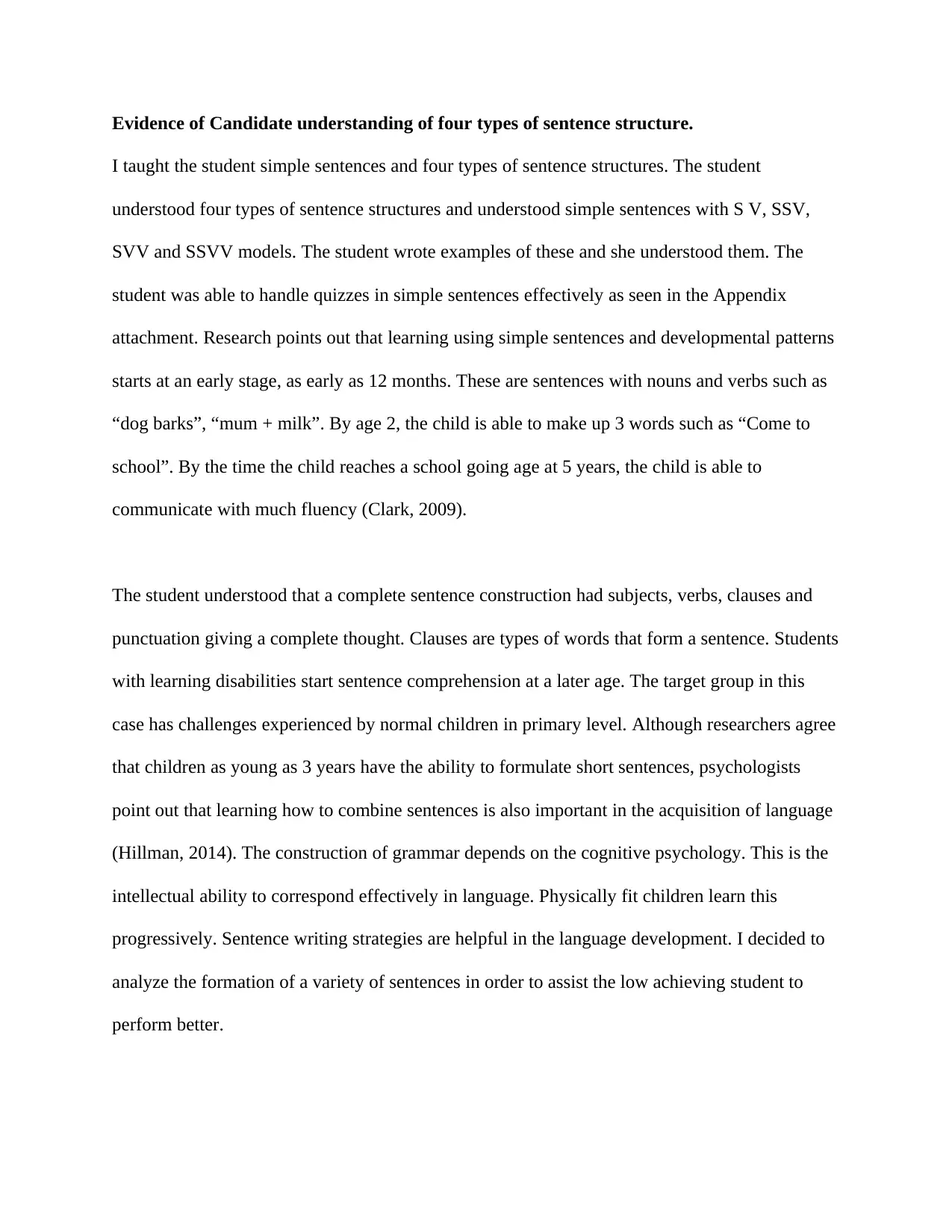
Evidence of Candidate understanding of four types of sentence structure.
I taught the student simple sentences and four types of sentence structures. The student
understood four types of sentence structures and understood simple sentences with S V, SSV,
SVV and SSVV models. The student wrote examples of these and she understood them. The
student was able to handle quizzes in simple sentences effectively as seen in the Appendix
attachment. Research points out that learning using simple sentences and developmental patterns
starts at an early stage, as early as 12 months. These are sentences with nouns and verbs such as
“dog barks”, “mum + milk”. By age 2, the child is able to make up 3 words such as “Come to
school”. By the time the child reaches a school going age at 5 years, the child is able to
communicate with much fluency (Clark, 2009).
The student understood that a complete sentence construction had subjects, verbs, clauses and
punctuation giving a complete thought. Clauses are types of words that form a sentence. Students
with learning disabilities start sentence comprehension at a later age. The target group in this
case has challenges experienced by normal children in primary level. Although researchers agree
that children as young as 3 years have the ability to formulate short sentences, psychologists
point out that learning how to combine sentences is also important in the acquisition of language
(Hillman, 2014). The construction of grammar depends on the cognitive psychology. This is the
intellectual ability to correspond effectively in language. Physically fit children learn this
progressively. Sentence writing strategies are helpful in the language development. I decided to
analyze the formation of a variety of sentences in order to assist the low achieving student to
perform better.
I taught the student simple sentences and four types of sentence structures. The student
understood four types of sentence structures and understood simple sentences with S V, SSV,
SVV and SSVV models. The student wrote examples of these and she understood them. The
student was able to handle quizzes in simple sentences effectively as seen in the Appendix
attachment. Research points out that learning using simple sentences and developmental patterns
starts at an early stage, as early as 12 months. These are sentences with nouns and verbs such as
“dog barks”, “mum + milk”. By age 2, the child is able to make up 3 words such as “Come to
school”. By the time the child reaches a school going age at 5 years, the child is able to
communicate with much fluency (Clark, 2009).
The student understood that a complete sentence construction had subjects, verbs, clauses and
punctuation giving a complete thought. Clauses are types of words that form a sentence. Students
with learning disabilities start sentence comprehension at a later age. The target group in this
case has challenges experienced by normal children in primary level. Although researchers agree
that children as young as 3 years have the ability to formulate short sentences, psychologists
point out that learning how to combine sentences is also important in the acquisition of language
(Hillman, 2014). The construction of grammar depends on the cognitive psychology. This is the
intellectual ability to correspond effectively in language. Physically fit children learn this
progressively. Sentence writing strategies are helpful in the language development. I decided to
analyze the formation of a variety of sentences in order to assist the low achieving student to
perform better.
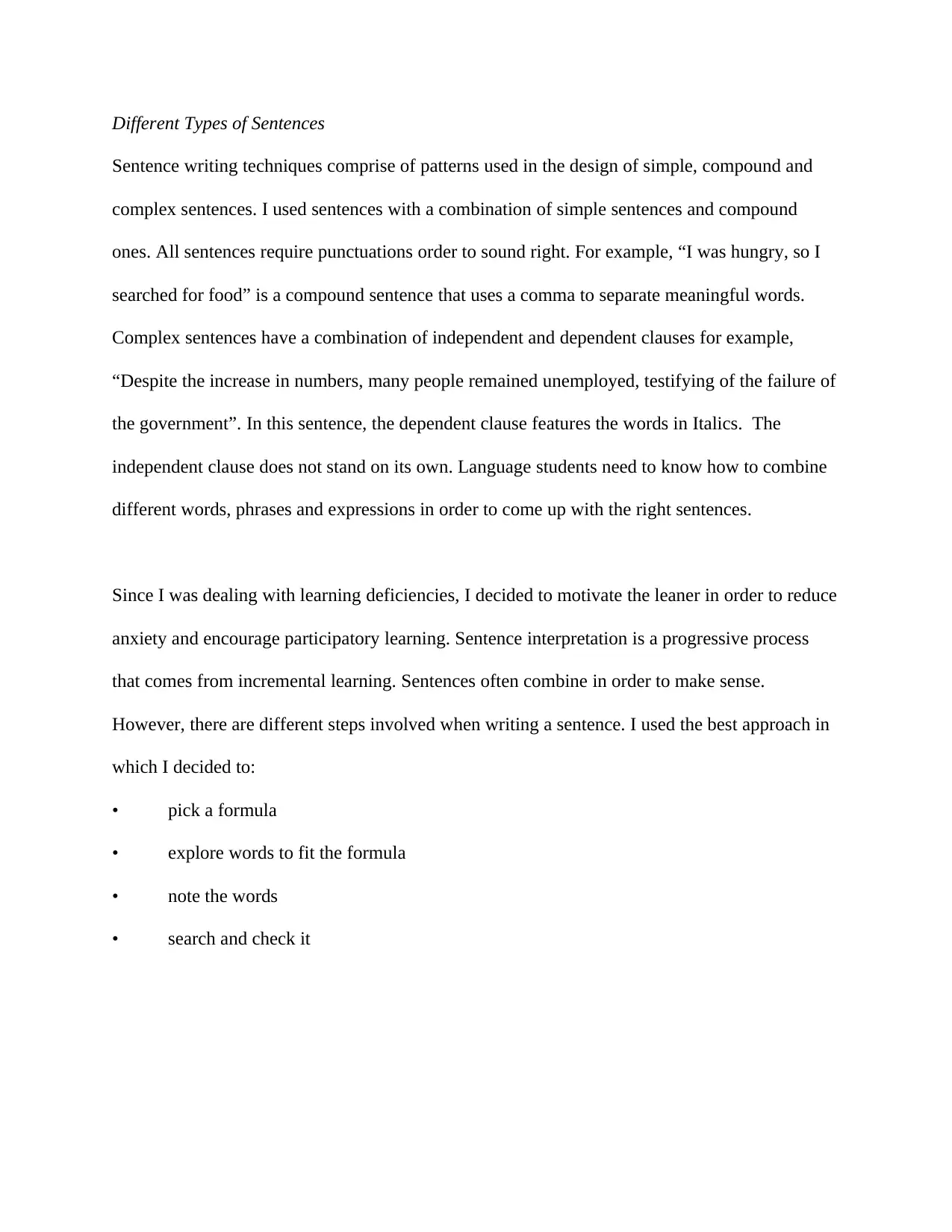
Different Types of Sentences
Sentence writing techniques comprise of patterns used in the design of simple, compound and
complex sentences. I used sentences with a combination of simple sentences and compound
ones. All sentences require punctuations order to sound right. For example, “I was hungry, so I
searched for food” is a compound sentence that uses a comma to separate meaningful words.
Complex sentences have a combination of independent and dependent clauses for example,
“Despite the increase in numbers, many people remained unemployed, testifying of the failure of
the government”. In this sentence, the dependent clause features the words in Italics. The
independent clause does not stand on its own. Language students need to know how to combine
different words, phrases and expressions in order to come up with the right sentences.
Since I was dealing with learning deficiencies, I decided to motivate the leaner in order to reduce
anxiety and encourage participatory learning. Sentence interpretation is a progressive process
that comes from incremental learning. Sentences often combine in order to make sense.
However, there are different steps involved when writing a sentence. I used the best approach in
which I decided to:
• pick a formula
• explore words to fit the formula
• note the words
• search and check it
Sentence writing techniques comprise of patterns used in the design of simple, compound and
complex sentences. I used sentences with a combination of simple sentences and compound
ones. All sentences require punctuations order to sound right. For example, “I was hungry, so I
searched for food” is a compound sentence that uses a comma to separate meaningful words.
Complex sentences have a combination of independent and dependent clauses for example,
“Despite the increase in numbers, many people remained unemployed, testifying of the failure of
the government”. In this sentence, the dependent clause features the words in Italics. The
independent clause does not stand on its own. Language students need to know how to combine
different words, phrases and expressions in order to come up with the right sentences.
Since I was dealing with learning deficiencies, I decided to motivate the leaner in order to reduce
anxiety and encourage participatory learning. Sentence interpretation is a progressive process
that comes from incremental learning. Sentences often combine in order to make sense.
However, there are different steps involved when writing a sentence. I used the best approach in
which I decided to:
• pick a formula
• explore words to fit the formula
• note the words
• search and check it
⊘ This is a preview!⊘
Do you want full access?
Subscribe today to unlock all pages.

Trusted by 1+ million students worldwide
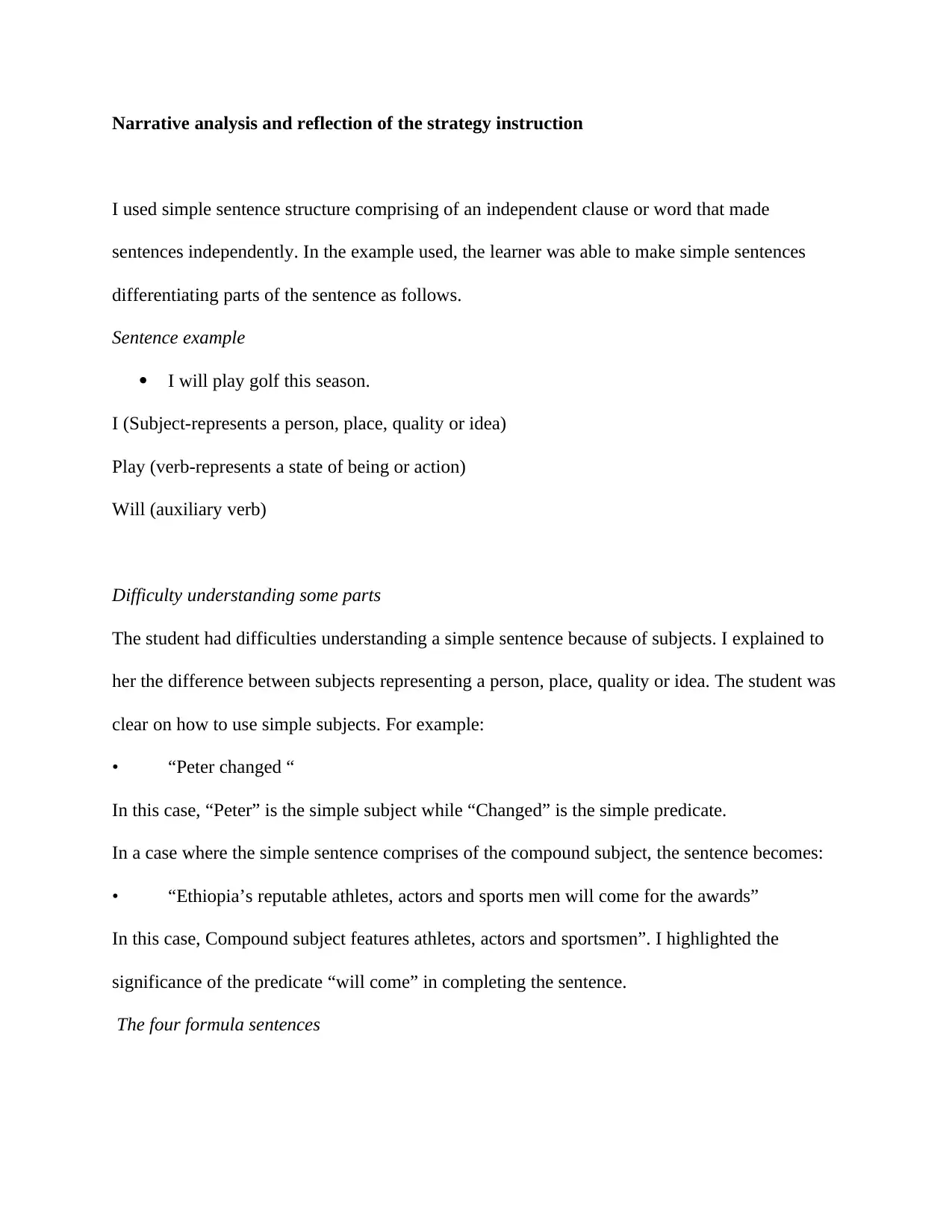
Narrative analysis and reflection of the strategy instruction
I used simple sentence structure comprising of an independent clause or word that made
sentences independently. In the example used, the learner was able to make simple sentences
differentiating parts of the sentence as follows.
Sentence example
I will play golf this season.
I (Subject-represents a person, place, quality or idea)
Play (verb-represents a state of being or action)
Will (auxiliary verb)
Difficulty understanding some parts
The student had difficulties understanding a simple sentence because of subjects. I explained to
her the difference between subjects representing a person, place, quality or idea. The student was
clear on how to use simple subjects. For example:
• “Peter changed “
In this case, “Peter” is the simple subject while “Changed” is the simple predicate.
In a case where the simple sentence comprises of the compound subject, the sentence becomes:
• “Ethiopia’s reputable athletes, actors and sports men will come for the awards”
In this case, Compound subject features athletes, actors and sportsmen”. I highlighted the
significance of the predicate “will come” in completing the sentence.
The four formula sentences
I used simple sentence structure comprising of an independent clause or word that made
sentences independently. In the example used, the learner was able to make simple sentences
differentiating parts of the sentence as follows.
Sentence example
I will play golf this season.
I (Subject-represents a person, place, quality or idea)
Play (verb-represents a state of being or action)
Will (auxiliary verb)
Difficulty understanding some parts
The student had difficulties understanding a simple sentence because of subjects. I explained to
her the difference between subjects representing a person, place, quality or idea. The student was
clear on how to use simple subjects. For example:
• “Peter changed “
In this case, “Peter” is the simple subject while “Changed” is the simple predicate.
In a case where the simple sentence comprises of the compound subject, the sentence becomes:
• “Ethiopia’s reputable athletes, actors and sports men will come for the awards”
In this case, Compound subject features athletes, actors and sportsmen”. I highlighted the
significance of the predicate “will come” in completing the sentence.
The four formula sentences
Paraphrase This Document
Need a fresh take? Get an instant paraphrase of this document with our AI Paraphraser
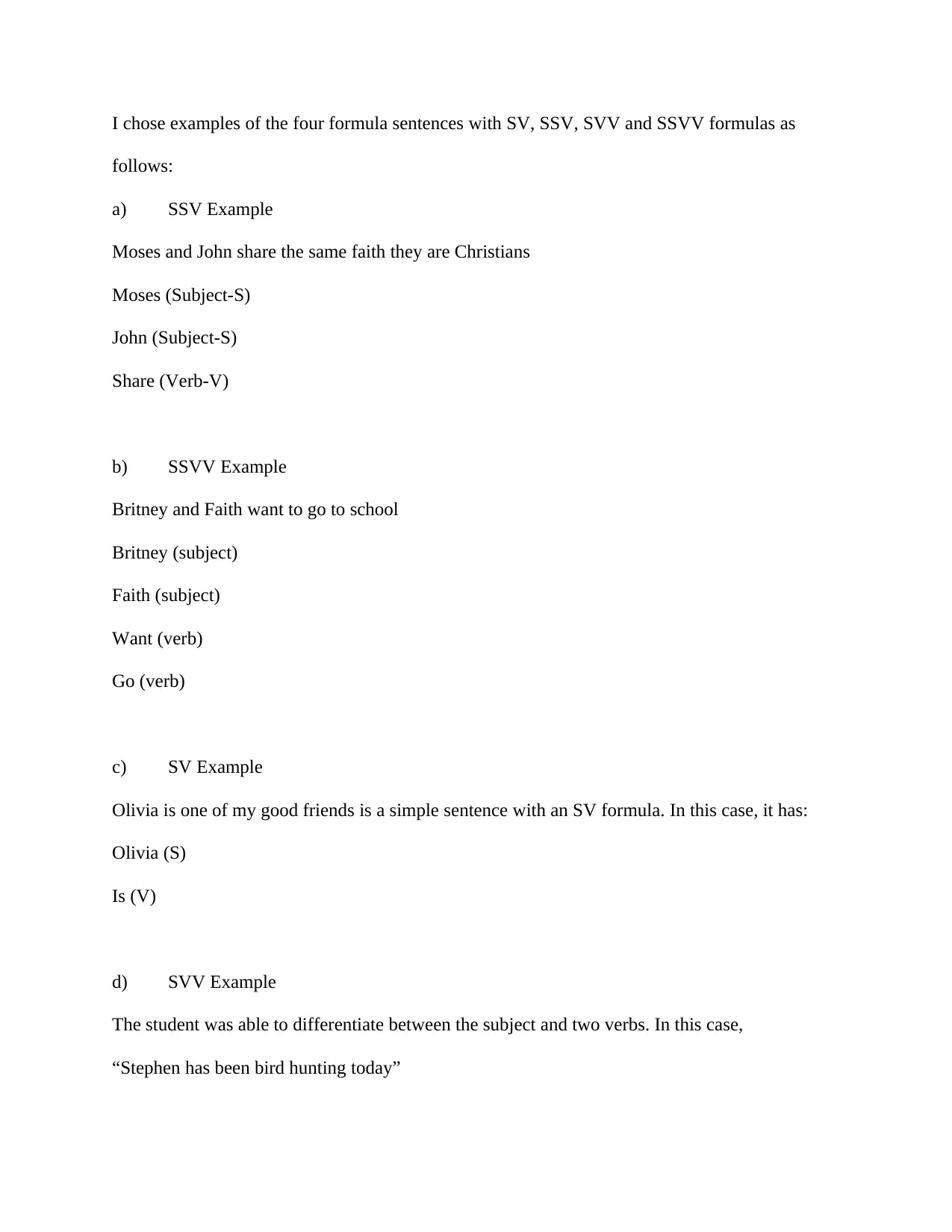
I chose examples of the four formula sentences with SV, SSV, SVV and SSVV formulas as
follows:
a) SSV Example
Moses and John share the same faith they are Christians
Moses (Subject-S)
John (Subject-S)
Share (Verb-V)
b) SSVV Example
Britney and Faith want to go to school
Britney (subject)
Faith (subject)
Want (verb)
Go (verb)
c) SV Example
Olivia is one of my good friends is a simple sentence with an SV formula. In this case, it has:
Olivia (S)
Is (V)
d) SVV Example
The student was able to differentiate between the subject and two verbs. In this case,
“Stephen has been bird hunting today”
follows:
a) SSV Example
Moses and John share the same faith they are Christians
Moses (Subject-S)
John (Subject-S)
Share (Verb-V)
b) SSVV Example
Britney and Faith want to go to school
Britney (subject)
Faith (subject)
Want (verb)
Go (verb)
c) SV Example
Olivia is one of my good friends is a simple sentence with an SV formula. In this case, it has:
Olivia (S)
Is (V)
d) SVV Example
The student was able to differentiate between the subject and two verbs. In this case,
“Stephen has been bird hunting today”
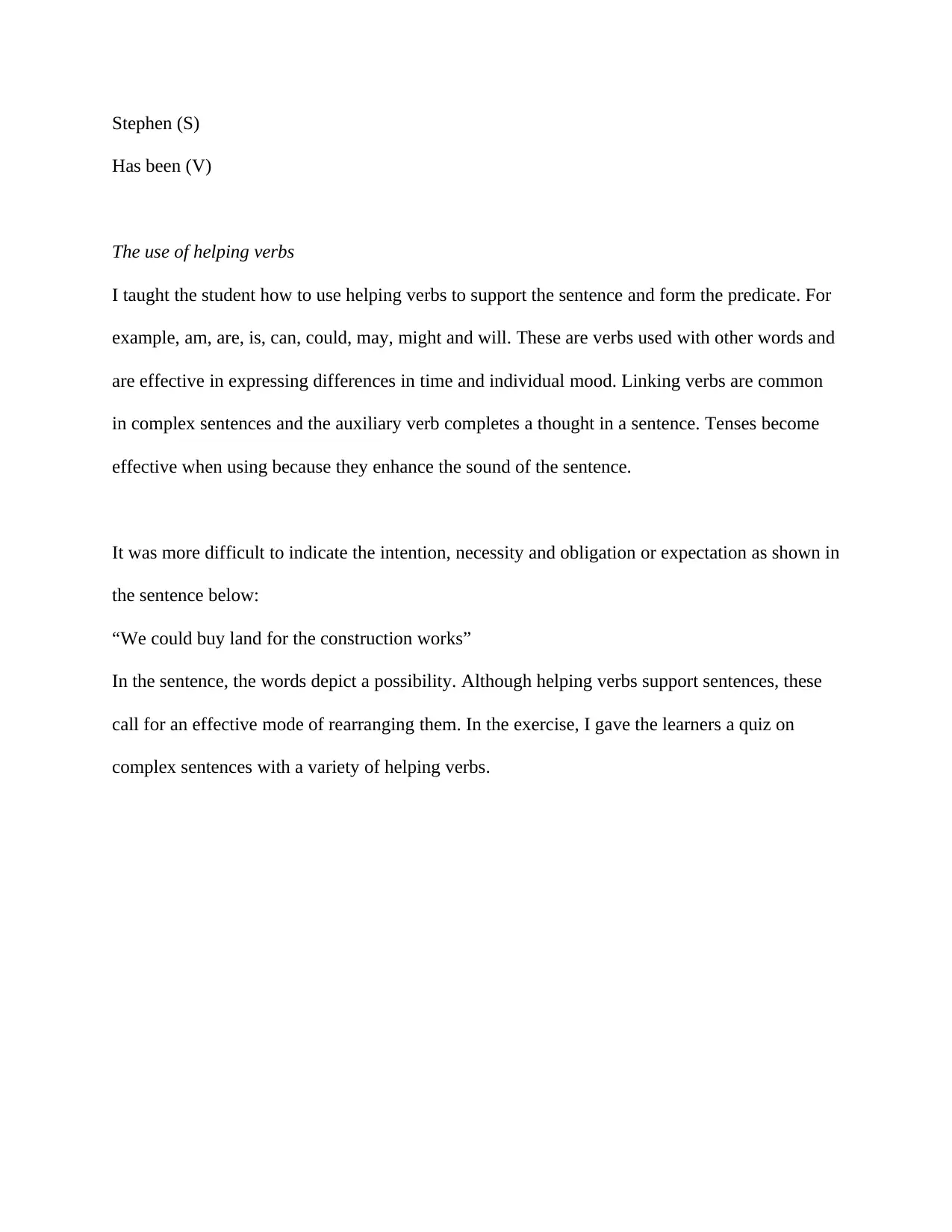
Stephen (S)
Has been (V)
The use of helping verbs
I taught the student how to use helping verbs to support the sentence and form the predicate. For
example, am, are, is, can, could, may, might and will. These are verbs used with other words and
are effective in expressing differences in time and individual mood. Linking verbs are common
in complex sentences and the auxiliary verb completes a thought in a sentence. Tenses become
effective when using because they enhance the sound of the sentence.
It was more difficult to indicate the intention, necessity and obligation or expectation as shown in
the sentence below:
“We could buy land for the construction works”
In the sentence, the words depict a possibility. Although helping verbs support sentences, these
call for an effective mode of rearranging them. In the exercise, I gave the learners a quiz on
complex sentences with a variety of helping verbs.
Has been (V)
The use of helping verbs
I taught the student how to use helping verbs to support the sentence and form the predicate. For
example, am, are, is, can, could, may, might and will. These are verbs used with other words and
are effective in expressing differences in time and individual mood. Linking verbs are common
in complex sentences and the auxiliary verb completes a thought in a sentence. Tenses become
effective when using because they enhance the sound of the sentence.
It was more difficult to indicate the intention, necessity and obligation or expectation as shown in
the sentence below:
“We could buy land for the construction works”
In the sentence, the words depict a possibility. Although helping verbs support sentences, these
call for an effective mode of rearranging them. In the exercise, I gave the learners a quiz on
complex sentences with a variety of helping verbs.
⊘ This is a preview!⊘
Do you want full access?
Subscribe today to unlock all pages.

Trusted by 1+ million students worldwide
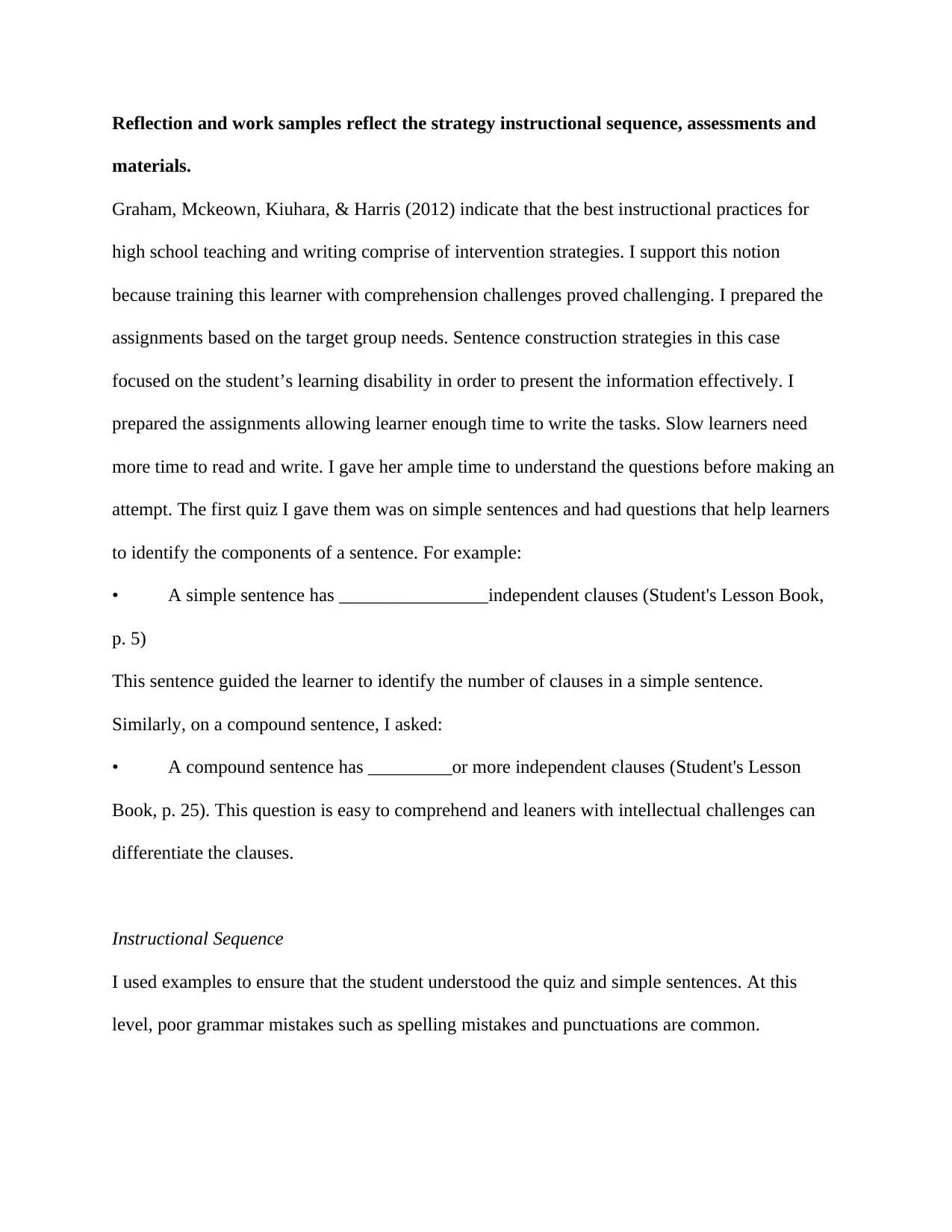
Reflection and work samples reflect the strategy instructional sequence, assessments and
materials.
Graham, Mckeown, Kiuhara, & Harris (2012) indicate that the best instructional practices for
high school teaching and writing comprise of intervention strategies. I support this notion
because training this learner with comprehension challenges proved challenging. I prepared the
assignments based on the target group needs. Sentence construction strategies in this case
focused on the student’s learning disability in order to present the information effectively. I
prepared the assignments allowing learner enough time to write the tasks. Slow learners need
more time to read and write. I gave her ample time to understand the questions before making an
attempt. The first quiz I gave them was on simple sentences and had questions that help learners
to identify the components of a sentence. For example:
• A simple sentence has ________________independent clauses (Student's Lesson Book,
p. 5)
This sentence guided the learner to identify the number of clauses in a simple sentence.
Similarly, on a compound sentence, I asked:
• A compound sentence has _________or more independent clauses (Student's Lesson
Book, p. 25). This question is easy to comprehend and leaners with intellectual challenges can
differentiate the clauses.
Instructional Sequence
I used examples to ensure that the student understood the quiz and simple sentences. At this
level, poor grammar mistakes such as spelling mistakes and punctuations are common.
materials.
Graham, Mckeown, Kiuhara, & Harris (2012) indicate that the best instructional practices for
high school teaching and writing comprise of intervention strategies. I support this notion
because training this learner with comprehension challenges proved challenging. I prepared the
assignments based on the target group needs. Sentence construction strategies in this case
focused on the student’s learning disability in order to present the information effectively. I
prepared the assignments allowing learner enough time to write the tasks. Slow learners need
more time to read and write. I gave her ample time to understand the questions before making an
attempt. The first quiz I gave them was on simple sentences and had questions that help learners
to identify the components of a sentence. For example:
• A simple sentence has ________________independent clauses (Student's Lesson Book,
p. 5)
This sentence guided the learner to identify the number of clauses in a simple sentence.
Similarly, on a compound sentence, I asked:
• A compound sentence has _________or more independent clauses (Student's Lesson
Book, p. 25). This question is easy to comprehend and leaners with intellectual challenges can
differentiate the clauses.
Instructional Sequence
I used examples to ensure that the student understood the quiz and simple sentences. At this
level, poor grammar mistakes such as spelling mistakes and punctuations are common.
Paraphrase This Document
Need a fresh take? Get an instant paraphrase of this document with our AI Paraphraser
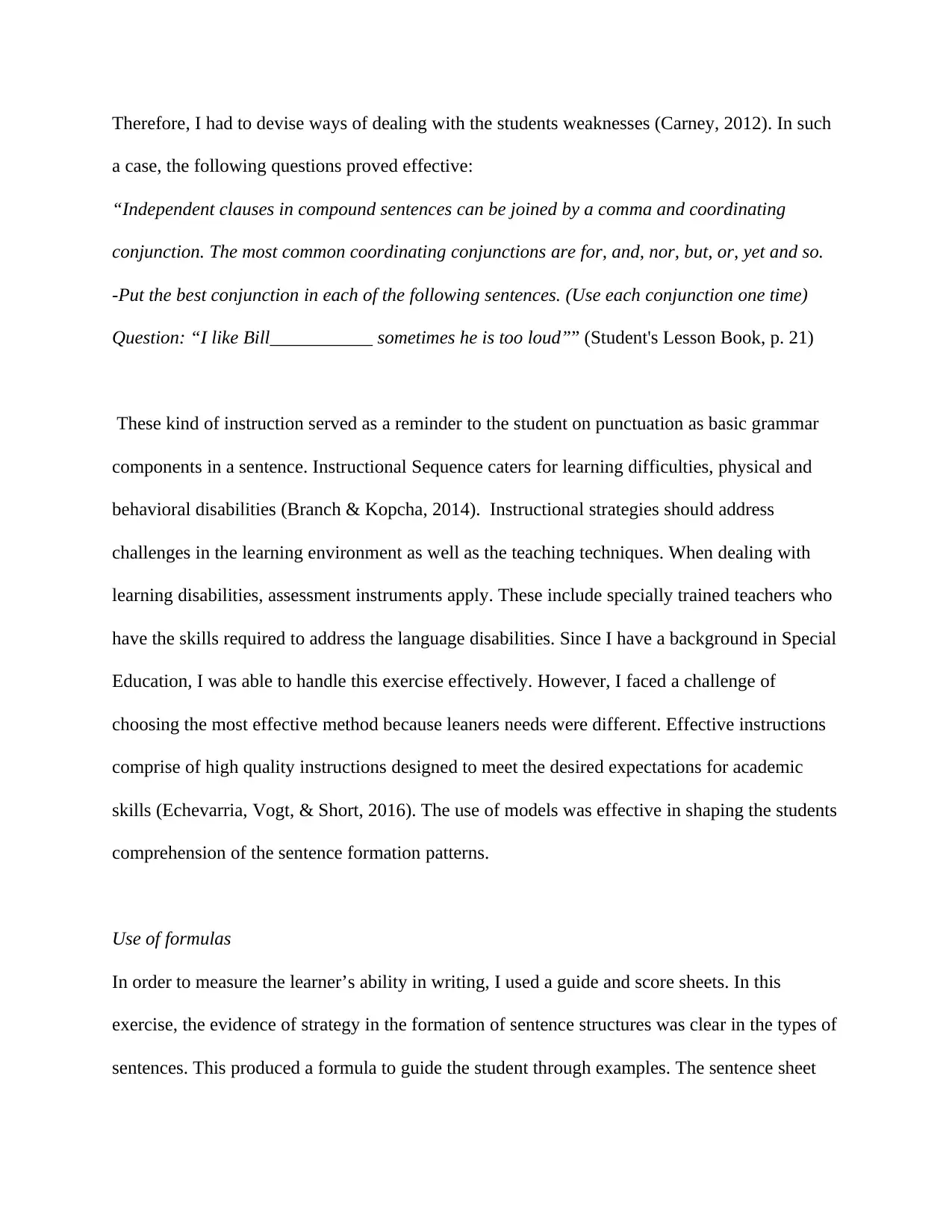
Therefore, I had to devise ways of dealing with the students weaknesses (Carney, 2012). In such
a case, the following questions proved effective:
“Independent clauses in compound sentences can be joined by a comma and coordinating
conjunction. The most common coordinating conjunctions are for, and, nor, but, or, yet and so.
-Put the best conjunction in each of the following sentences. (Use each conjunction one time)
Question: “I like Bill___________ sometimes he is too loud”” (Student's Lesson Book, p. 21)
These kind of instruction served as a reminder to the student on punctuation as basic grammar
components in a sentence. Instructional Sequence caters for learning difficulties, physical and
behavioral disabilities (Branch & Kopcha, 2014). Instructional strategies should address
challenges in the learning environment as well as the teaching techniques. When dealing with
learning disabilities, assessment instruments apply. These include specially trained teachers who
have the skills required to address the language disabilities. Since I have a background in Special
Education, I was able to handle this exercise effectively. However, I faced a challenge of
choosing the most effective method because leaners needs were different. Effective instructions
comprise of high quality instructions designed to meet the desired expectations for academic
skills (Echevarria, Vogt, & Short, 2016). The use of models was effective in shaping the students
comprehension of the sentence formation patterns.
Use of formulas
In order to measure the learner’s ability in writing, I used a guide and score sheets. In this
exercise, the evidence of strategy in the formation of sentence structures was clear in the types of
sentences. This produced a formula to guide the student through examples. The sentence sheet
a case, the following questions proved effective:
“Independent clauses in compound sentences can be joined by a comma and coordinating
conjunction. The most common coordinating conjunctions are for, and, nor, but, or, yet and so.
-Put the best conjunction in each of the following sentences. (Use each conjunction one time)
Question: “I like Bill___________ sometimes he is too loud”” (Student's Lesson Book, p. 21)
These kind of instruction served as a reminder to the student on punctuation as basic grammar
components in a sentence. Instructional Sequence caters for learning difficulties, physical and
behavioral disabilities (Branch & Kopcha, 2014). Instructional strategies should address
challenges in the learning environment as well as the teaching techniques. When dealing with
learning disabilities, assessment instruments apply. These include specially trained teachers who
have the skills required to address the language disabilities. Since I have a background in Special
Education, I was able to handle this exercise effectively. However, I faced a challenge of
choosing the most effective method because leaners needs were different. Effective instructions
comprise of high quality instructions designed to meet the desired expectations for academic
skills (Echevarria, Vogt, & Short, 2016). The use of models was effective in shaping the students
comprehension of the sentence formation patterns.
Use of formulas
In order to measure the learner’s ability in writing, I used a guide and score sheets. In this
exercise, the evidence of strategy in the formation of sentence structures was clear in the types of
sentences. This produced a formula to guide the student through examples. The sentence sheet
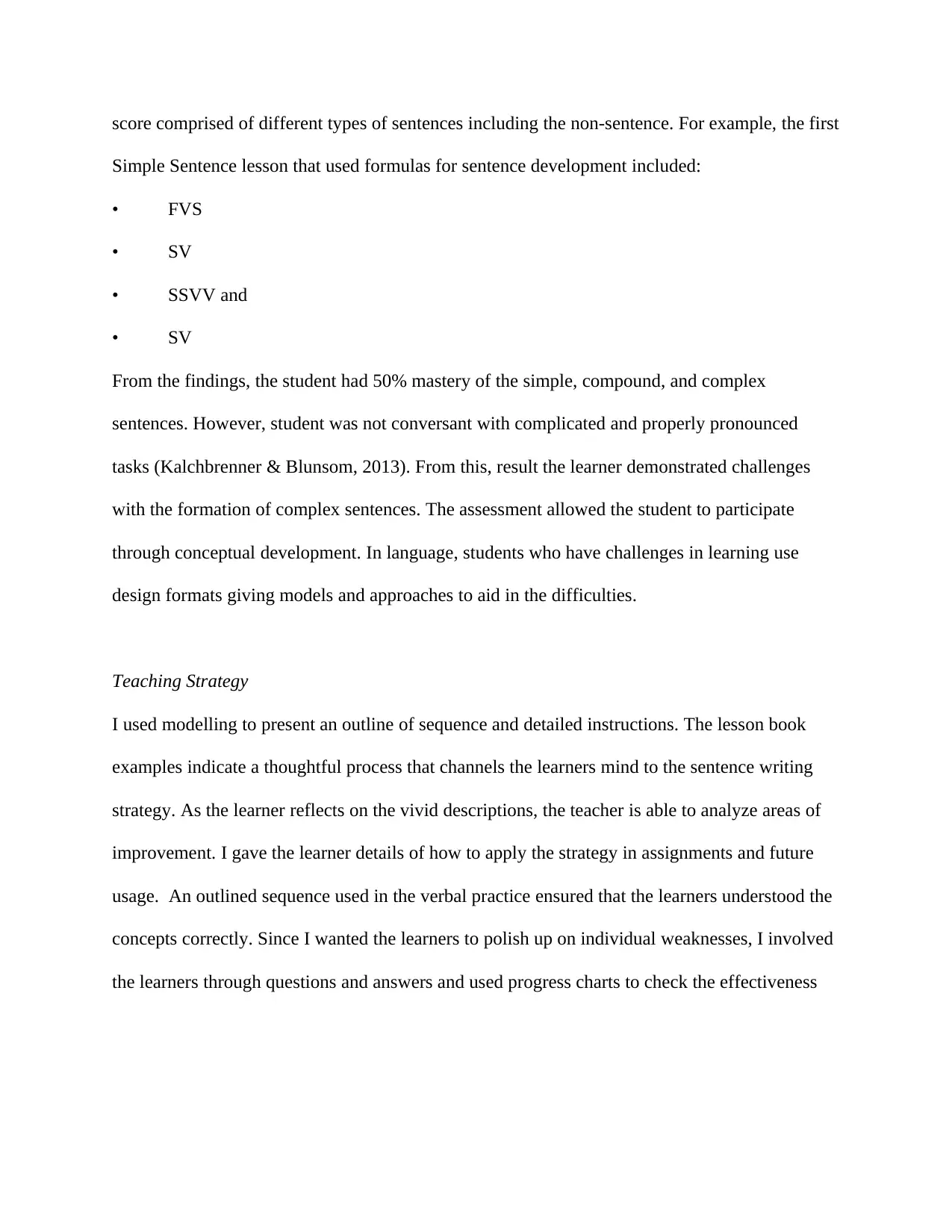
score comprised of different types of sentences including the non-sentence. For example, the first
Simple Sentence lesson that used formulas for sentence development included:
• FVS
• SV
• SSVV and
• SV
From the findings, the student had 50% mastery of the simple, compound, and complex
sentences. However, student was not conversant with complicated and properly pronounced
tasks (Kalchbrenner & Blunsom, 2013). From this, result the learner demonstrated challenges
with the formation of complex sentences. The assessment allowed the student to participate
through conceptual development. In language, students who have challenges in learning use
design formats giving models and approaches to aid in the difficulties.
Teaching Strategy
I used modelling to present an outline of sequence and detailed instructions. The lesson book
examples indicate a thoughtful process that channels the learners mind to the sentence writing
strategy. As the learner reflects on the vivid descriptions, the teacher is able to analyze areas of
improvement. I gave the learner details of how to apply the strategy in assignments and future
usage. An outlined sequence used in the verbal practice ensured that the learners understood the
concepts correctly. Since I wanted the learners to polish up on individual weaknesses, I involved
the learners through questions and answers and used progress charts to check the effectiveness
Simple Sentence lesson that used formulas for sentence development included:
• FVS
• SV
• SSVV and
• SV
From the findings, the student had 50% mastery of the simple, compound, and complex
sentences. However, student was not conversant with complicated and properly pronounced
tasks (Kalchbrenner & Blunsom, 2013). From this, result the learner demonstrated challenges
with the formation of complex sentences. The assessment allowed the student to participate
through conceptual development. In language, students who have challenges in learning use
design formats giving models and approaches to aid in the difficulties.
Teaching Strategy
I used modelling to present an outline of sequence and detailed instructions. The lesson book
examples indicate a thoughtful process that channels the learners mind to the sentence writing
strategy. As the learner reflects on the vivid descriptions, the teacher is able to analyze areas of
improvement. I gave the learner details of how to apply the strategy in assignments and future
usage. An outlined sequence used in the verbal practice ensured that the learners understood the
concepts correctly. Since I wanted the learners to polish up on individual weaknesses, I involved
the learners through questions and answers and used progress charts to check the effectiveness
⊘ This is a preview!⊘
Do you want full access?
Subscribe today to unlock all pages.

Trusted by 1+ million students worldwide
1 out of 43
Related Documents
Your All-in-One AI-Powered Toolkit for Academic Success.
+13062052269
info@desklib.com
Available 24*7 on WhatsApp / Email
![[object Object]](/_next/static/media/star-bottom.7253800d.svg)
Unlock your academic potential
Copyright © 2020–2025 A2Z Services. All Rights Reserved. Developed and managed by ZUCOL.





